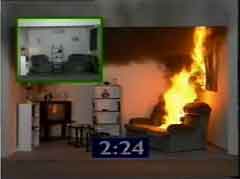It’s old news, but still worth paying attention to. Last Friday, the Washington state House of Representatives passed legislation to ban toxic flame retardants known as PBDEs—which are something of an obsession around these parts.
This is a pretty big deal, since the bill covers deca-PBDEs—the only form of the compound that’s still widely used, as far as I know. Washington’s bill doesn’t ban deca outright. There are still exemptions, and the ban is phased in over several years. Still, it treats deca much more aggressively than, say, a recently announced Canadian PBDE ban that environmental advocates have called “toothless,” because it leaves deca largely unscathed. Deca appears to be less toxic than the other forms of PBDEs, and also less likely to accumulate in human bodies. But there’s growing evidence that, over time, deca can break down into other, more dangerous forms of PBDEs—meaning that if we continue to use deca, we could be setting our grandkids up for some tough times down the road.
The key to the bill’s passage (besides the aerospace exemption, which kept Boeing from nixing it) is that the ban on deca is phased in: it only takes affect after an independent fire safety commision reviews of the safety and effectiveness of alternative flame retardants. That seems prudent—PBDEs may be bad, but fire is bad too, and other fire retardants may be no safer. Phasing out deca makes sense, provided that there are good alternatives.
Which brings me to my second piece of news: here’s a press release that recently landed in my inbox, about a new fire inhibitor —
(The video’s kind of hard to find: follow this link, click on “AF21” and then “demo”. )
I don’t mean to be a shill for this new compound. I have no idea if it works as advertised. But looking at the video, two things struck me.
First, a fire retardant does what it says: it retards fires, giving you some time in case your TV shorts or you drop a cigarette on your couch. Fire retardancy certainly prevents a lot of fires—but it isn’t the be-all, end-all of fire safety. A couch that meets fire retardancy standards can still go up in smoke; you just have to expose it to flame for a while. And when it does ignite, boy, the smoke from that couch can be toxic.
My point here: there’s a lot of room for improvement in today’s generation of fire retardants—both in the safety of the chemicals, and in their effectiveness in preventing fires.
Second, banning PBDEs may be one way of unleashing the creative juices of chemists, to help make products that are even safer. I mean, scientists really like technical challenges, and they’re pretty good at solving them. (Full disclosure—my father worked as a chemical engineer for several years, before discovering his true passion: accounting.) So I’m not worried at all that a PBDE ban will lead to more fires. In fact, at this point, I’d be more worried that a commitment to the status quo on fire retardance will mean uncessary fires, with unnecessarily toxic smoke.
No wonder that state fire chiefs and firefighters associations support the PBDE ban.








Alan Durning
Wow!
Dave K.
I’ve got a cloth recliner from IKEA that is deca free. It turns out that all IKEA’s furniture is completely PBDE free. The Washington Department of Ecology notes here that Apple, Dell, Sony, and Xerox have phased out PBDEs too. If these major companies can do it, other companies should be required to follow suit.